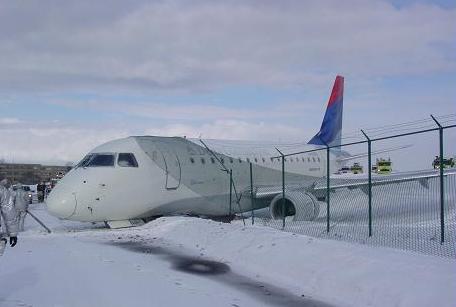The US NTSB is requesting that the FAA put in place more comprehensive rejected landing simulation training and other safety advances in the wake of the Shuttle America ERJ170 overrun accident at the Cleveland Hopkins International airport on 18 February 2007.

Pilots of Delta Connection Flight 6448, carrying 71 passengers and four crewmembers, descended below the appropriate minimum altitude for the approach and lost visual contact with the runway end in a snow squall, according to the NTSB’s final report issued 3 April.
The first officer, flying the aircraft at the time, continued with the landing despite the fatigued captain’s call for a go-around. The aircraft “landed long” on the “contaminated runway”, overrunning the end of Runway 28, contacting an instrument landing system antenna and striking a perimeter fence.
Three passengers received minor injuries and the aircraft’s nose gear collapsed. Investigators say the pilots failed to “use reverse thrust and braking to their maximum effectiveness.”
The NTSB is asking the FAA to require airlines, air taxis and operators of larger business jets to require initial, upgrade, transition and recurrent simulator training that includes decision-making for rejected landings below 50ft (15.2m) accompanied by a “rapid reduction in visual cues”. While the FAA currently requires missed approach practice, generally at 50ft above the runway threshold, the criteria “are general in nature”, says the NTSB, and do not require simultaneous loss of visual contact with the ground.
Other training or operational recommendations from the Shuttle America incident include practicing maximum performance landings on contaminated runways, providing a written policy that allows either pilot to call for a go-around before landing, and putting in place a policy that allows flight crewmembers to “decline assignments or remove themselves from duty if they were impaired by a lack of sleep.”
Source: FlightGlobal.com
















